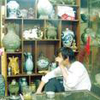观点正文
Life's Common Threads
作者:Barbara Coyner 2005-12-31 00:00:00来源:艺术家提供
A-
A+
By Barbara Coyner Art of the West Sep/Oct.2004.
Calling two countries home and feeling deep connections to both,Zhang Wen Xin returns to China each year to paint in hopes of portraying the personal sides of his native land.He might journey to Mongolia to watch a regional celebration with its horses and pageantry,or he might travel to a remote island near Taiwan to paint the inhabitants as they handcraft traditional wooden boats.
For months,Zhang will live on his native soil,savoring the famliar flavors,spending time with his wife,Chai Ding Fang,a craft arts professor,and visiting with his son,an artist who still lives in the homeland.Then he will pack his bags,return to Albuquerque,New Mexico,and step back into his American shoes,Having immigrated to the United States in 1987,Zhang today values both his worlds and uses his art to encourage better understanding between his adopted home and his birthplace.His world perspective is unique and ,during his 76 years,he has witnessed political upheaval,econcomic experiments,and amazing social change.
Zhang focuses on the faces of the people and the storiesconveyed through their expressions.By capturing the everyday people doing ordinary things,he elevates them as actors in a bigger story,linking nation to nation through the common threads of life.
“Many Chinese artists come to the United States and want to paint the Western scenes,the horses,and the people here,”Says Zhang,laboring to translate his Chinese thoughts into spoken English,“But the more they understand their own country,the more they change their subjects back to Chinese,”Althouth Zhang Paints Western themes,he also has embraced the move back to Chinese subjects and continues to wander the Chinese countryside, painting its rural landscapes and people.
Zhang Wen Xin By Stanly cuba Southwest Art April 1992.
Zhang’s struggle to become a painter is rooted in his youth in pre-world war II China.In 1937 when Zhang was 9,the Japanese invaded Tienjin and Beijing.He remembers the date as his coming of age and a time of commitment to his country.
Zhanb’s exposure to the lifestyle and art of the West convinced him that there was a need for a new art in China.
Contributing to Zhang’s belief in art reform was Chinese writer Lu Xun(1886-1936).
Calling two countries home and feeling deep connections to both,Zhang Wen Xin returns to China each year to paint in hopes of portraying the personal sides of his native land.He might journey to Mongolia to watch a regional celebration with its horses and pageantry,or he might travel to a remote island near Taiwan to paint the inhabitants as they handcraft traditional wooden boats.
For months,Zhang will live on his native soil,savoring the famliar flavors,spending time with his wife,Chai Ding Fang,a craft arts professor,and visiting with his son,an artist who still lives in the homeland.Then he will pack his bags,return to Albuquerque,New Mexico,and step back into his American shoes,Having immigrated to the United States in 1987,Zhang today values both his worlds and uses his art to encourage better understanding between his adopted home and his birthplace.His world perspective is unique and ,during his 76 years,he has witnessed political upheaval,econcomic experiments,and amazing social change.
Zhang focuses on the faces of the people and the storiesconveyed through their expressions.By capturing the everyday people doing ordinary things,he elevates them as actors in a bigger story,linking nation to nation through the common threads of life.
“Many Chinese artists come to the United States and want to paint the Western scenes,the horses,and the people here,”Says Zhang,laboring to translate his Chinese thoughts into spoken English,“But the more they understand their own country,the more they change their subjects back to Chinese,”Althouth Zhang Paints Western themes,he also has embraced the move back to Chinese subjects and continues to wander the Chinese countryside, painting its rural landscapes and people.
Zhang Wen Xin By Stanly cuba Southwest Art April 1992.
Zhang’s struggle to become a painter is rooted in his youth in pre-world war II China.In 1937 when Zhang was 9,the Japanese invaded Tienjin and Beijing.He remembers the date as his coming of age and a time of commitment to his country.
Zhanb’s exposure to the lifestyle and art of the West convinced him that there was a need for a new art in China.
Contributing to Zhang’s belief in art reform was Chinese writer Lu Xun(1886-1936).
推荐关键字:张文新
注:本站上发表的所有内容,均为原作者的观点,不代表雅昌艺术网的立场,也不代表雅昌艺术网的价值判断。
- “率意·本真·诗心——张文新油画作品展”2020-12-26
- 画家张文新素描手稿展在邯郸韩玉臣美术馆开2019-07-17
- 寄语我的忘年交2016-03-14
- 张文新:前辈画家新作焕发耀人光芒2013-04-16
- 早春二月—张文新的风景2013-03-25
- 张文新艺术研究会在北京成立2013-03-22
- 张文新笔下的农村姑娘2012-10-10
- “尘封的画箱——张文新50至80年代写生”作2012-09-18
- “名家足迹”张文新艺术回顾展在国家大剧院2012-09-16
- “艺慧文新-张文新的绘画艺术展”将在京举行2012-09-10
艺术号作家
- 奥岩
- 蔡万霖
- 曹兴诚
- 陈孝信
- 陈建明
- 陈 曦
- 陈晓峰
- 陈东升
- 邓丁三
- 杜曦云
- 段 君
- 冯家驳
- 陈 墨
- 郭庆祥
- 杭春晓
- 何桂彦
- 何光锐
- 胡 人
- 孔达达
- 廖廖
- 黄 专
- 季 涛
- 冀少峰
- 贾方舟
- 贾廷峰
- 李国华
- 李公明
- 李小山
- 王正悦
- 刘幼铮
- 刘尚勇
- 帽哥
- 刘双舟
- 刘九洲
- 刘礼宾
- 刘骁纯
- 刘 越
- 林明杰
- 鲁 虹
- 吕 澎
- 吕立新
- 马学东
- 马 健
- 彭 德
- 彭 锋
- 邵玮尼
- 沈语冰
- 水天中
- 宋永进
- 孙振华
- 孙欣
- 陶咏白
- 佟玉洁
- 王春辰
- 王栋栋
- 王端廷
- 王凤海
- 王 萌
- 王南溟
- 王小箭
- 吴念亲
- 西 沐
- 夏可君
- 夏彦国
- 徐子林
- 姚 谦
- 杨 卫
- 一西平措
- 殷双喜
- 尹 毅
- 尤 洋
- 于 洋
- 岳 峰
- 张 辉
- 张翛翰
- 战 平
- 赵 力
- 赵 榆
- 周文翰
- 朱浩云
- 朱绍良
- 朱万章
- 史金淞
最新文章
热门文章
没有相关内容!
博客·论坛热点

-
高校美术实践教育的当...
高校美术实践教育在过去的几十年里的发展几乎是不尽如人...详情
- 责任编辑:杨晓萌
- yangxiaomeng@artron.net
- 010-84599337-847

